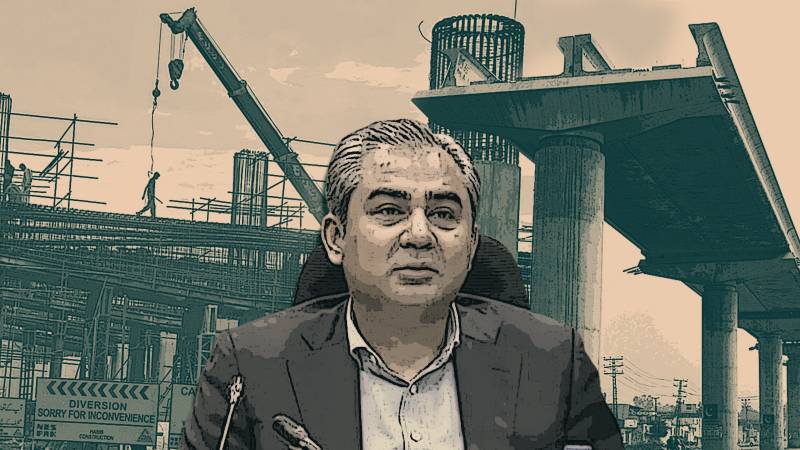
In the bustling streets of Lahore, banners boldly flaunt the notorious "Mohsin Speed," an emblem of the caretaker chief minister Mohsin Naqvi's relentless commitment to showcase the unprecedented pace at which infrastructure projects are hurtling towards completion in his tenure.
As Lahore transforms with the remarkable speed of infrastructure projects, from flyovers to underpasses across the city, a critical discourse emerges on the toll this development exacts on the environment. The proliferation of signal-free corridors, flyovers, and underpasses, while promising a respite from traffic congestions, raises concerns about air pollution in a city choking on the smog of progress.
Successive governments, including the PTI and PML-N in Punjab, have shared an obsession with these infrastructure projects. While such developments may appeal to the electorate, the allure of signal-free corridors inadvertently promotes individual vehicle ownership, contributing to heightened vehicular emissions and a decline in air quality.
This penchant for flyovers and underpasses is not unique to the current administration. Successive governments, including the PTI and PML-N in Punjab, have shared an obsession with these infrastructure projects. While such developments may appeal to the electorate, the allure of signal-free corridors inadvertently promotes individual vehicle ownership, contributing to heightened vehicular emissions and a decline in air quality.
In an era where environmental sustainability should be a paramount consideration in urban planning, this model, aimed at streamlining traffic flow, appears counterproductive. As mentioned in Dr. Umair Javaid’s recent article, the research findings from environmental policy specialist Dawar Butt indicate a noteworthy reduction in crop fires in Pakistani Punjab, registering a decline of nearly 60 percent compared to the average between 2016 and 2020. Contrary to previous associations of smog with crop burning, the contemporary challenge is predominantly linked to the escalating emissions from vehicles in Pakistani cities.
Anywhere from a third to over half of the air pollution in urban areas can be attributed to emissions from vehicles.
Research by Abdullah Bajwa and Hassan Sheikh delves into the intricate relationship between road transport and urban air pollution. Their research, published in the journal Air, highlights the substantial contribution of vehicular emissions to poor air quality. Their analysis indicates that anywhere from a third to over half of the air pollution in urban areas can be attributed to emissions from vehicles. This nuanced understanding reinforces the urgency for targeted interventions in the transport sector to effectively address and mitigate the persistent and evolving challenge of smog.
The very air that Lahore breathes now bears the imprint of its development model — a model that appears, in its relentless pace, to have overlooked the paramount consideration of environmental sustainability.
As successive governments share an infatuation with signal-free corridors, the unintended consequence is a cityscape choked by smog, where each passing vehicle becomes a contributor to the atmospheric haze. The very air that Lahore breathes now bears the imprint of its development model — a model that appears, in its relentless pace, to have overlooked the paramount consideration of environmental sustainability. The statistics, research, and ever-thickening smog compel Lahore to ponder whether "Mohsin Speed" is, indeed, an accelerant propelling the city towards a climate catastrophe, and if so, at what cost does progress come?
The government needs to reset its priorities. Now is the time to learn from successful global models that prioritise cost-efficient and environment-friendly public transportation over extensive infrastructure projects.
As other global cities have exemplified, investing in comprehensive public transport systems is not only feasible but also essential for sustainable urban development. For instance, cities like Bogotá have successfully implemented Bus Rapid Transit (BRT) systems, providing efficient and affordable public transport options that significantly reduce individual vehicle usage. This strategic and forward-thinking move aligns with the growing global consensus on the significance of public transportation in achieving urban sustainability and should serve as a guiding principle for Lahore's future development endeavours.
For in the grand tapestry of development, the health of the planet is also deteriorating at "Mohsin Speed," urging us to steer this trajectory towards a future where progress is synonymous with environmental stewardship.
As Pakistan grapples with the dual challenges of economic disparity, with 40 percent of its populace living below the poverty line, and the suffocating grip of smog, the need for a paradigm shift becomes imperative. Public transportation must transcend its functional role and emerge as the nucleus of the country’s commitment to combat air pollution and curb vehicular emissions. It is a clarion call to synchronise urban development with environmental stewardship, ensuring that Lahore's progress reverberates not only in its infrastructure but also in the breath of fresh air it provides to its citizens.
In this pivotal moment, setting priorities straight becomes an act of foresight — a recognition that true progress is measured not only by the speed of construction but by the enduring legacy left for future generations.
A commitment to robust, accessible public transportation is a commitment to both the economic welfare of the populace and the environmental health of the city. It is time for the government to lead the orchestra towards a symphony of sustainable urban development, where the melody of progress harmonises seamlessly with the rhythm of environmental stewardship.
For in the grand tapestry of development, the health of the planet is also deteriorating at "Mohsin Speed," urging us to steer this trajectory towards a future where progress is synonymous with environmental stewardship. Lahore, in embracing this vision, has the opportunity to redefine its narrative from a victim to a visionary and showcase that true leadership lies in sustainable and environmentally conscious development.

